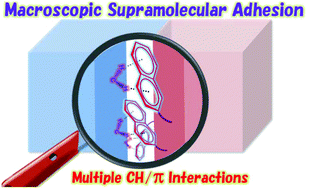Exploiting CH/π interactions in robust supramolecular adhesives†
Abstract
Supramolecular adhesives (SAs) have attracted great interest as a promising adhesion methodology in many fields. Although various SAs employing well-established non-covalent motifs have been reported to date, examples with marked binding strengths >2 MPa are still limited to SAs based on specific high-energy non-covalent interactions, e.g. hydrogen bonds, ionic bonds, host–guest interactions, and metal–ligand complexations. Reported herein is a new class of SAs based on multiple CH/π interactions. We designed the SAs with multiple-naphthalene-ring-functionalised polyacrylamide as a π donor and a polyolefin consisting of alkyl groups as a π acceptor. The macroscopic supramolecular assemblies achieved binding strengths in the range 2.1–2.6 MPa, comparable to those of SAs based on high-energy non-covalent interactions. Moreover, the adhesive exhibited long-term (i.e. 30 days) stability in wet and humid environments. Finally, we demonstrated potential application of our adhesive as an industrial adhesive. Our SAs will overturn the preconception that adhesion strength driven by low-energy non-covalent interactions is low, and they hold potential for a range of useful applications in chemistry, materials science, and relevant industrial manufacturing.

- This article is part of the themed collection: Industry R&D collection


 Please wait while we load your content...
Please wait while we load your content...